Della donna hanno narrato artisti di ogni periodo storico, ne hanno osservato la sacralità, l’evanescenza, l’essere generatrice di vita e poi ancora il fascino, il suo essere tentatrice e provocatrice e infine ne hanno approfondito l’aspetto più profondo, psicologico, fatto di insicurezze e sofferenze ma anche di forza. Nell’arte contemporanea grazie all’affermarsi di molte donne artiste, molto più che nei secoli precedenti, il punto di vista sulla figura femminile si è ampliato, ha rivelato aspetti non presi in considerazione prima perché provenienti da creative che conoscono molto bene un’interiorità troppo spesso misteriosa ed enigmatica agli occhi degli uomini. La protagonista di oggi svela l’aspetto allegro, spensierato, della donna, ritraendola nei momenti in cui si dedica a ciò che ama, negli attimi di bel vivere che si ritaglia nella sua quotidianità.
I ritratti femminili che sono passati alla storia hanno sempre raffigurato le protagoniste immortalate come muse ispiratrici, come icone da adorare e da ammirare, pur lasciando percepire la loro distanza, la loro inarrivabilità che costituiva forse il maggiore fascino agli occhi di artisti come Botticelli, Leonardo, Vermeer; con il progredire dei secoli e con l’avvicinarsi di quel florido periodo storico denominato Belle Epoque, la figura della donna assunse un aspetto differente poiché all’immagine idilliaca dei pomeriggi all’aria aperta raccontati dagli artisti aderenti all’Impressionismo, come le celeberrime opere di Claude Monet e Pierre-Auguste Renoir, si affiancò la sensualità conturbante delle donne di Gustav Klimt, maggiore esponente del Secessionismo Viennese, o Art Nouveau come venne denominato in Francia quel movimento volto a celebrare il lusso e il benessere del periodo antecedente alla prima guerra mondiale, e infine in Henri de Tolouse-Lautrec venne messo in evidenza il lato più peccaminoso della donna, il suo essere anche dissoluta esattamente come l’uomo. Tanto quanto fortemente erotico era il mondo raccontato da Egon Schiele, fatto di nudità, di sessualità non più repressa bensì manifestata apertamente da entrambe le parti, quella maschile e quella femminile, aprendo così le porte a un nuovo punto di vista mai considerato in precedenza. Parallelamente però, o forse grazie a quella maggiore apertura generale, nell’arte come nella vita, si cominciarono ad affermare grandi pittrici donne destinate per il loro coraggio, per la loro espressività, per la loro capacità di approfondire temi inesplorati di sé e del mondo ancora prevalentemente maschile in cui erano nate, a diventare punti di riferimento per le generazioni successive di artiste; due tra le pioniere dell’arte moderna furono Tamara de Lempicka e Frida Kahlo entrambe in grado, ognuna con il proprio stile, di dare una versione differente dell’essere femminile in quel periodo complesso che fu il primo ventennio del Novecento. La prima decisamente Art Decò, orientata dunque a un approccio più estetico, quasi patinato in cui doveva emergere la modernità delle sue protagoniste, quell’inseguire il lusso e il benessere in maniera autonoma, senza più aspettare di riceverlo dall’uomo bensì conquistandolo autonomamente; la seconda invece appartenente al Surrealismo, intensa, controversa figura capace di mettere su tela il suo personale percorso di vita, il dolore per l’incidente invalidante che le cambiò la vita ma a cui mai si arrese, e l’amore ossessivo per Diego Rivera che l’accompagnò costantemente fino alla sua morte. Tutto questo era evidente a chi si poneva davanti alle sue opere e che non poteva non prendere atto del coraggio della grande artista messicana, del suo stile semplice eppure in grado di nascondere concetti e significati che a un primo sguardo non erano percepiti. L’artista polacca Halina Benkovics sceglie a sua volta di narrare la donna attraverso il suo sguardo di donna, evidenziandone però non più la sofferenza, l’interiorità ferita, al contrario si sofferma sulla leggerezza, sulla piacevolezza nell’inseguire i sogni e nel compiere quei gesti piacevoli in grado di riempire di gioia ogni singolo giorno.
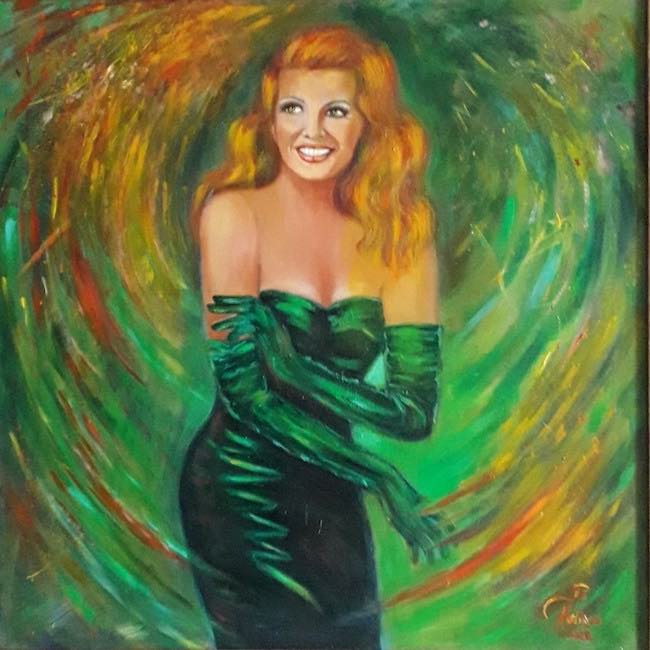
Il suo stile sembra essere una fusione tra il Realismo con cui descrive i dettagli e gli sguardi delle sue protagoniste, e l’Espressionismo cromatico perché gli sfondi e alcuni particolari si accordano all’emozione, alla sensazione che l’artista desidera immortalare nell’opera.
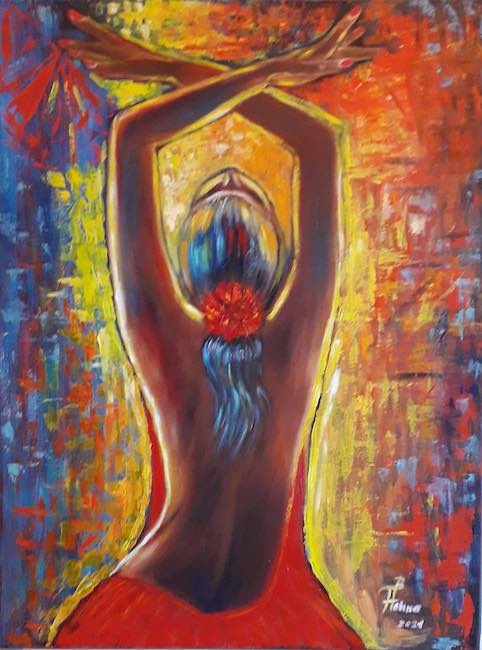
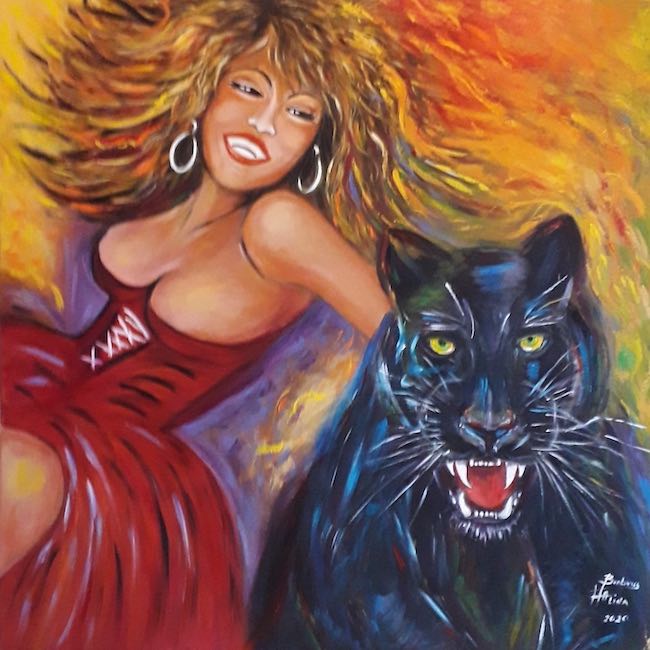
Gli sfondi, sempre indefiniti e non contestualizzati, sembrano avvolgere le donne poste di volta in volta al centro della scena, come se costituissero l’accompagnamento al loro sentire, come se si accordassero alle emozioni, al vissuto nel momento in cui vengono immortalate; a volte più vivaci, altre più tenui, le tonalità scelte si accordano con lo stato d’animo, con il frangente che stanno vivendo quelle donne sorridenti, pensierose, maliziose, gioiose, innamorate che Halina Benkovics racconta quasi come se fossero sfaccettature della stessa medaglia, descrive frammenti di attimi di vita esaltandone l’aspetto piacevole, effervescente, divertente che appartiene a quelle parentesi apparentemente trascurabili dell’esistenza mentre invece ne costituisce l’essenza stessa. Il dialogo tra l’interno e l’esterno è pertanto in perfetta armonia, quasi a costituire un’interazione energetica che si manifesta in maniera diretta per raggiungere l’osservatore e conquistarlo con quelle tonalità forti e decise, come spesso è la vita.
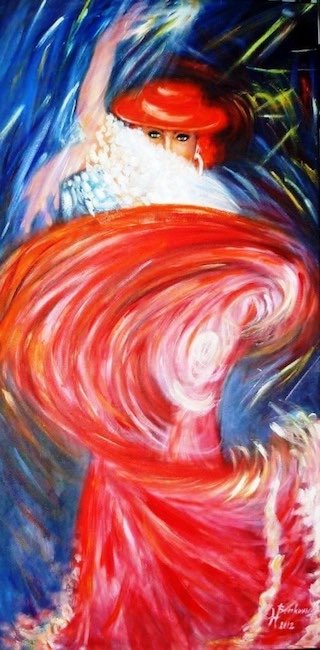
Nella tela Flamenco l’abito della ballerina è protagonista assoluto tanto quanto il suo sguardo su cui la Benkovics vuole attrarre l’attenzione dell’osservatore, dunque il rosso carminio dei volant del tipico vestito spagnolo diventa un’unica curva voluttuosa da cui gli occhi della donna lasciano emergere la passione, l’amore per quel ballo liberatorio e intenso che perfettamente si accorda al suo temperamento. Tutto il resto della composizione è indefinito quasi a sfiorare l’Astrattismo perché ciò che conta è il dettaglio, il magnetismo dell’essenza di quella figura femminile che comunica a chi è di fronte all’opera, quanto sia importante nella sua vita dedicarsi a quella passione che la fa sentire libera di esprimere se stessa.
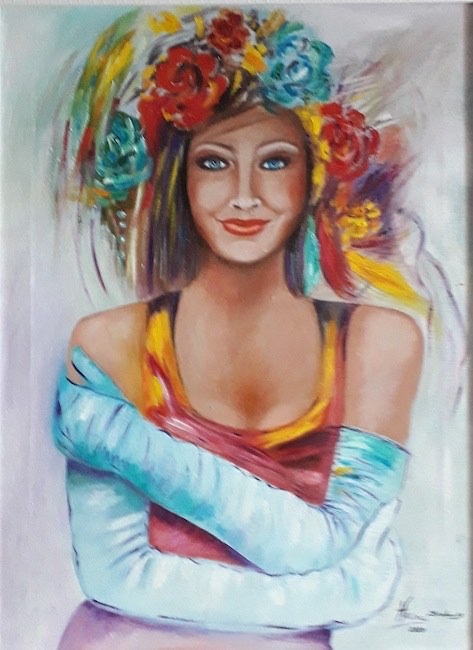
In Lo sguardo che ride invece l’attenzione dell’artista si amplia all’intera protagonista, a dimostrazione di quanto malgrado l’armonia e la bellezza dell’immagine generale, di cui l’occhio riesce a cogliere ogni particolare, ciò che colpisce di più è lo sguardo, l’essenza dell’anima, la trasparenza dell’interiorità attraverso cui la donna, ma anche l’essere umano in generale, riesce a esprimere ciò che sente. In questo caso la ragazza sembra lasciar trasparire una gioia misurata, la consapevolezza dell’aver finalmente visto verificarsi quel risultato tanto atteso, di aver conquistato quella meta, che sia materiale o personale non importa, che non può che renderla appagata e al tempo stesso soddisfatta; le braccia sono chiuse e sembrano volersi stringere a se stesse, sottolineando quel senso di completezza che scaturisce dalla consapevolezza di aver dato il massimo e di essere riuscita a raggiungere l’obiettivo. Qui la gamma cromatica è realista mentre lo sfondo è soffuso, sfumato per non distogliere l’attenzione dall’immagine principale.
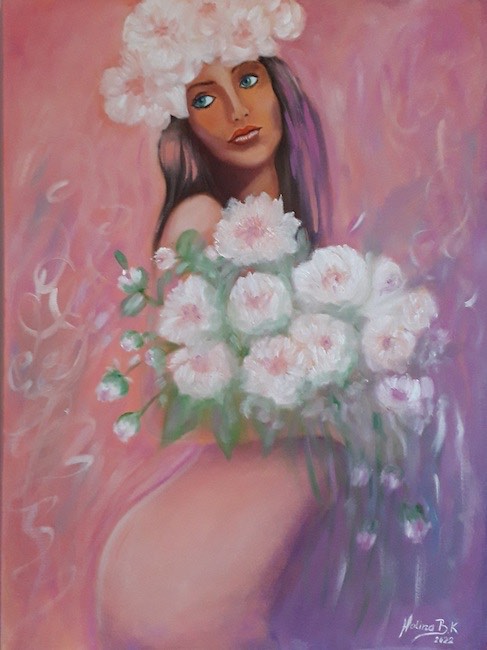
Nel dipinto Giardino estivo invece Halina Benkovics sottolinea la delicatezza della figura femminile attraverso colori tenui, rosati, morbidi, che sembrano avvolgerla evidenziando il carattere romantico, sognatore, così tanto che riesce a trovare la propria dimensione ideale quando circondata dal mondo floreale. Eppure la sua posa nasconde una leziosità di fondo, come se fosse consapevole quanto quella purezza e quell’ingenuità possano catturare le attenzioni, possano costituire un’attrattiva per quel mondo maschile in cui lei sogna di trovare l’anima gemella, quella che la renderà protagonista per tutta la vita.
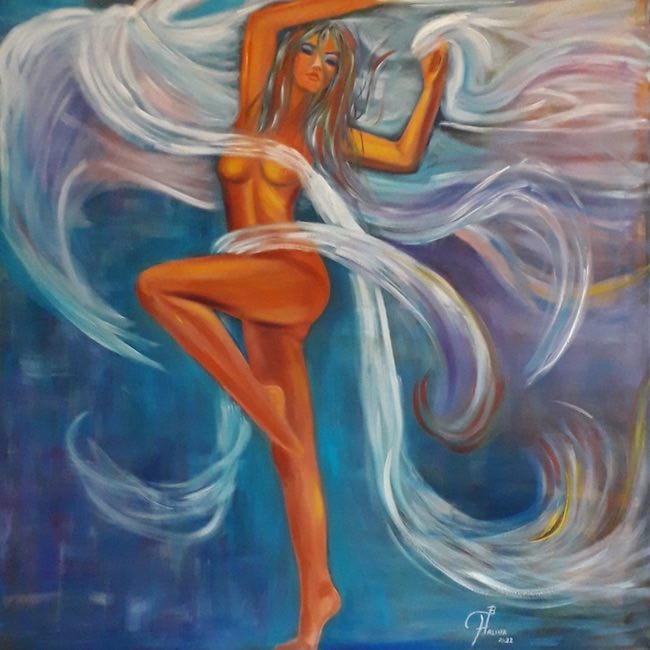
Le emozioni pure, pulite, gioiose, il piacere di compiere gesti semplici e di dedicarsi a ciò che nella quotidianità può rendere felici sono le protagoniste delle opere di Halina Benkovics, svelando il suo approccio alla vita, gioioso, positivo, divertito e sempre sorridente perché in fondo è quello il segreto del bel vivere, coltivare tutto ciò che può rendere ogni giorno un giorno indimenticabile; anche quando appartiene all’attesa, al sogno o al ricordo, come emerge nell’opera Vento d’amore in cui la donna sembra avvolta dall’idea del sentimento di cui sta aspettando l’arrivo, o che ha visto allontanarsi senza però perdere la fiducia che qualcosa di migliore possa sopraggiungere. Halina Benkovics, nata in Polonia e recentemente divisa tra Vienna e Milano, si forma come autodidatta riuscendo a perfezionare la sua tecnica seguendo corsi di pittura a olio, acrilico, acquerello e pastelli; ha all’attivo numerose mostre personali e collettive in Austria, in Polonia, in Italia e negli Stati Uniti, ha ricevuto premi e menzioni e le sue opere sono inserite all’interno delle principali pubblicazioni dedicate all’arte contemporanea.
HALINA BENKOVICS-CONTATTI
Email: halinabenkovics@yahoo.it
Sito web: https://www.galleriamilanese.com/halina-benkovics
Facebook: https://www.facebook.com/halina.benkovicskrajewska
Instagram: https://www.instagram.com/halina_benkovics/
The effervescence of the female universe in the Realism at expressionist hues of Halina Benkovics
Artists from all periods of history have narrated about women, observing their sacredness, their evanescence, their being the giver of life and then again their fascination, their being temptresses and provocateurs, and finally they have delved into their deeper, psychological aspect, made up of insecurities and suffering but also of strength. In contemporary art, thanks to the emergence of many women artists, much more than in previous centuries, the point of view on the female figure has broadened, has revealed aspects not previously taken into consideration because they come from creative artists who know very well an interiority that is all too often mysterious and enigmatic in the eyes of men. Today’s protagonist reveals the cheerful, carefree aspect of the woman, portraying her in the moments when she devotes herself to what she loves, in the moments of good living that she carves out in her everyday life.
The female portraits that have gone down in history have always portrayed the protagonists immortalised as inspiring muses, as icons to be adored and admired, while allowing one to perceive their distance, their unattainability that constituted perhaps the greatest fascination in the eyes of artists such as Botticelli, Leonardo, Vermeer; as the centuries progressed and the florid historical period known as the Belle Epoque approached, the figure of women took on a different aspect, as the idyllic image of afternoons in the open air portrayed by the artists adhering to Impressionism, such as the celebrated artworks of Claude Monet and Pierre-Auguste Renoir, was flanked by the perturbing sensuality of the women of Gustav Klimt, the greatest exponent of Viennese Secessionism, or Art Nouveau as it was called in France that movement celebrating the luxury and welfare of the pre-World War I period, and finally in Henri de Tolouse-Lautrec was emphasised the more sinful side of women, their being just as dissolute as men. Just as strongly erotic was the world portrayed by Egon Schiele, made up of nudity, of sexuality no longer repressed but openly manifested on both sides, male and female, thus opening the door to a new point of view never previously considered.
At the same time, however, or perhaps thanks to that greater general openness, in art as in life, great women painters began to assert themselves, destined for their courage, their expressiveness, their ability to delve into unexplored themes of themselves and of the still predominantly male world in which they were born, to become points of reference for subsequent generations of female artists; two of the pioneers of modern art were Tamara de Lempicka and Frida Kahlo, both of whom were able, each with their own style, to give a different version of being female in that complex period that was the first two decades of the 20th century. The first was decidedly Art Deco, oriented therefore towards a more aesthetic, almost glossy approach in which the modernity of hers protagonists was to emerge, that pursuit of luxury and wealth in an autonomous manner, no longer waiting to receive it from men but conquering it autonomously; the second instead belonged to Surrealism, an intense, controversial figure capable of putting on canvas her personal life path, the pain of the disabling accident that changed her life but to which she never gave up, and the obsessive love for Diego Rivera that accompanied her constantly until her death. All this was evident to those who stood in front of her paintings and who could not fail to take note of the courage of the great Mexican artist, of her simple style yet capable of concealing concepts and meanings that were not perceived at first glance. The Polish artist Halina Benkovics chooses in turn to narrate the woman through her woman’s gaze, but no longer highlighting her suffering, her wounded interiority; on the contrary, she dwells on lightness, on the pleasantness of pursuing dreams and performing those pleasant gestures capable of filling every single day with joy.
Her style seems to be a fusion between Realism with which she describes the details and the looks of her protagonists, and chromatic Expressionism because the backgrounds and certain details match the emotion, the feeling that the artist wishes to immortalise in the artwork. The backgrounds, always indefinite and not contextualised, seem to envelop the women placed in the centre of the scene, as if they accompanied their feelings, as if they were in tune with the emotions, with the experience of the moment in which they are immortalised; sometimes brighter, sometimes softer, the tones chosen are in tune with the state of mind, with the moment in which these smiling, thoughtful, mischievous, joyful, loving women that Halina Benkovics recounts almost as if they were facets of the same coin, it describes fragments of moments of life, exalting the pleasant, effervescent, amusing aspect that belongs to those apparently negligible parentheses of existence, while in fact constituting its very essence. The dialogue between inside and outside is therefore in perfect harmony, almost constituting an energetic interaction that manifests itself in a direct manner to reach the observer and win him over with those strong, decisive tones, as life often is. In the painting Flamenco, the dancer’s dress is as much the absolute protagonist as her gaze on which Benkovics wants to draw the observer’s attention, so the carmine red of the ruffles of the typical Spanish dress becomes a single voluptuous curve from which the woman’s eyes let her passion emerge, her love for that liberating and intense dance that perfectly matches her temperament. All the rest of the composition is undefined almost verging on Abstractionism because what counts is the detail, the magnetism of the essence of that female figure who communicates to those in front of the artwork how important it is in her life to devote herself to that passion that makes her feel free to express herself. In Lo sguardo che ride (The Laughing Gaze), on the other hand, the artist’s attention is extended to the entire protagonist, demonstrating that despite the harmony and beauty of the general image, of which the eye is able to grasp every detail, what is most striking is the gaze, the essence of the soul, the transparency of the interiority through which the woman, but also the human being in general, is able to express what she feels. In this case, the girl seems to allow a measured joy to transpire, the awareness of having finally seen that long-awaited result come true, of having conquered that goal, whether material or personal it does not matter, which cannot but make her satisfied and at the same time fulfilled; her arms are closed and seem to want to clasp themselves, emphasising that sense of completeness that springs from the awareness of having given her all and succeeded in achieving the objective. Here the colour palette is realistic while the background is soft, blurred so as not to distract attention from the main image.
In the painting Summer Garden, on the other hand, Halina Benkovics emphasises the delicacy of the female figure through soft, rosy colours that seem to envelop her, highlighting her romantic, dreamy character, so much so that she manages to find her ideal dimension when surrounded by the floral world. Yet her pose conceals an underlying leisuredness, as if she were aware of how much that purity and naivety can capture attention, can be an attraction for that male world in which she dreams of finding her soul mate, the one who will make her a protagonist for the rest of her life. Pure, clean, joyful emotions, the pleasure of making simple gestures and devoting oneself to what in everyday life can make one happy are the protagonists of Halina Benkovics’ artworks, revealing her approach to life, joyful, positive, amused and always smiling because after all that is the secret of the good life, cultivating everything that can make every day an unforgettable day; even when it belongs to waiting, dreaming or remembering, as can be seen in the painting Vento d’amore (Wind of Love) in which the woman seems to be wrapped up in the idea of the feeling whose arrival she is awaiting, or which she has seen recede without, however, losing faith that something better may come along. Halina Benkovics, born in Poland and recently dividing her life between Vienna and Milan, trained as a self-taught artist, perfecting her technique by following courses in oil painting, acrylics, watercolours and pastels; she has numerous solo and group exhibitions in Austria, Poland, Italy and the United States, has received prizes and mentions, and her artworks are included in the main publications dedicated to contemporary art.













